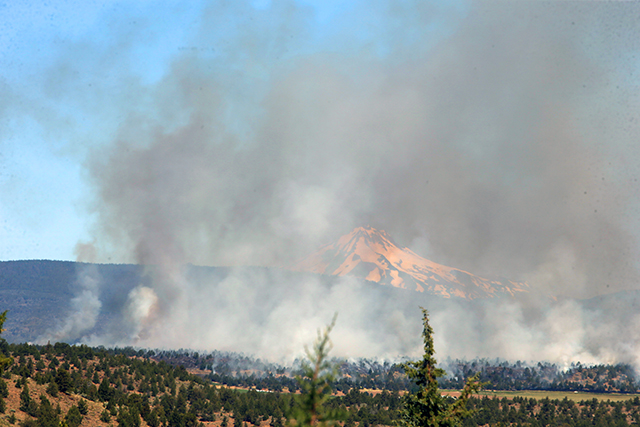Skiing and snowboarding
Published 4:00 am Wednesday, January 16, 2013
From easy, gentle slopes in the trees, to steep, technical couloirs high atop Cascade peaks, the Central Oregon backcountry offers something for every skier or snowboarder willing to venture beyond the chairlifts.
Those seeking the most easily accessible backcountry slopes would probably prefer Vista Butte or Tumalo Mountain, while those who crave a more arduous mountaineering adventure might look to Broken Top or South Sister.
Here is a rundown of some of the more popular backcountry ski and snowboard locations in Central Oregon: (These are all fairly well-known spots within the backcountry community, so don’t worry if you have a secret powder stash — it won’t be listed here.)
• Vista Butte
A short drive from Bend, Vista Butte is perhaps the simplest backcountry skiing and snowboarding site in the area.
Vista Butte Sno-park, 20 miles southwest of Bend, is basically just some extra room for parking along the shoulder of the highway on the way to Mount Bachelor.
From the sno-park, reaching the summit of the 6,619-foot Vista Butte to the northeast involves a 700-foot elevation gain along the well-worn skin track. The southwest portion of the butte offers the best lines for skiing and snowboarding, and it is not all that steep.
Most of the snowriding on Vista Butte is among the trees, so skiers and snowboarders should watch out for tree wells, areas around the bases of trees where unconsolidated snow collects.
“Vista is kind of a jewel,” said Carlos Cummings, avalanche safety instructor and backcountry guide for Oregon Ski Guides in Bend. “It’s very short, very mellow. It’s a great place to go on a first tour where you’re not having to worry too much about avalanches.”
• Tumalo Mountain
Located just across Century Drive from Mount Bachelor, Tumalo Mountain (elevation 7,775 feet) is probably the most accessible, and most frequently visited backcountry skiing and snowboarding spot in Central Oregon.
The skin track starts at Dutchman Flat Sno-park and climbs 1,400 feet up the south side of the mountain to the summit. The payoff for snowriders is the steep pitch down the treeless northwest bowl of Tumalo. Backcountry enthusiasts can spend a full day doing laps up and down the bowl.
“It’s quite quick and easy to get to for a significantly steep run,” Cummings said.
Tumalo is a mixed-used area, and the eastern half of the bowl is open to snowmobiles.
• Todd Ridge
Todd Ridge, the horseshoe ridge around the west and north flanks of Todd Lake, is a backcountry location that requires a significant step-up in commitment and skill level from Vista Butte and Tumalo.
A snowmobile is not required to access Todd Ridge, but it certainly is helpful. The distance from the Mt. Bachelor Nordic Center (the typical starting point) to Todd Lake is about two miles. The lake can be accessed via Cascade Lakes Highway (on a snowmobile or skis) or via backcountry ski trails from the common corridor that starts at the nordic center.
A well-used skin track starts from the Todd Lake trailhead (elevation 6,150 feet) and continues around the west side of Todd Lake.
“It is so popular that most people, when they’re expecting to be the first one of the day, they’ll see evidence of somebody being there earlier,” Cummings said.
The west and north ridges of the lake are the most popular areas to ski at Todd Ridge, according to Cummings.
“The skiing to your immediate left, above the entrance of the lake, is decent,” he noted. “If you continue on that skin path toward the back side of the lake, that’s where the more open glades and steeper terrain are, and that’s where most folks try to access.”
Cummings says the vertical drop of skiing from the top of the ridge to the lake ranges from about 600 to 800 feet. And, he adds, it is typically a safe place to ski and snowboard.
“I have never really seen a significant (snow) slide out there,” said Cummings, who skis at Todd Ridge frequently. “However, it’s good practice to always bring all that avalanche equipment (transceivers, probes, shovels) whether you’re going to Vista, Tumalo, Broken Top, etc.”
• Tam McArthur Rim
Accessing Tam McArthur Rim (or Tam Rim, as it is often called) requires a six-mile snowmobile ride from Three Creek Sno-park, just south of Sisters, to Three Creek Lake. Jutting 1,500 feet above the lake, the rocky Tam Rim stretches for two miles with perfectly pitched north-facing slopes — a scenic invitation for snowriders seeking deep, virgin powder.
Located near the lake are a number of yurts, dwellings where backcountry skiers can stay overnight to maximize their opportunity. Timberline Mountain Guides (which operates Oregon Ski Guides) and Three Sisters Backcountry Inc. offer guided ski trips at Tam Rim, which reaches as high as 7,732 feet in elevation.
Cummings says Tam Rim provides skiers and snowboarders “almost endless opportunities.” And, he notes, the north-facing slope is protected from the sun.
“It tends to have good pockets of snow really late after we have storms,” Cummings said. “The nice thing about it is, there’s everything from entry-level slopes to some pretty nasty, steep areas. And you don’t need mountaineering gear (crampons or ice axes).”
Most of the runs on Tam Rim range from 800 to 1,200 vertical feet, according to Shane Fox of Three Sisters Backcountry.
“Lapping an 800-foot bowl is awesome for backcountry skiing because you’re not skinning for too long before you drop in again,” Fox said.
• South Sister
South Sister is the perfect backcountry location for an intermediate skier or snowboarder looking to spend a full day deep in the mountains, according to Cummings. The wide-open terrain above the tree line features long and fairly steep slopes.
“You can drop several thousand vertical feet without even having to stop,” Cummings explained. “The beauty of South Sister is that it is bigger, and it does allow more intermediate folks the opportunity to get to a higher alpine environment and to get on some pretty cool slopes, whereas Broken Top is going to have more steep and narrow slopes, and more challenging skins.”
Reaching the South Sister trailhead in the winter requires a seven-mile snowmobile ride from Dutchman Flat Sno-park to Devils Lake. The skin track follows the South Sister climber’s trail used in the summer and fall.
Snowriders do not have to climb terribly far to find skiable lines, as the steep terrain just west of Moraine Lake offers good skiing, according to Cummings.
“There’s so much terrain out there that you could farm that snow all day and continue to make laps in the Moraine Lake area,” he said.
Other popular places to ski or snowboard higher up on the 10,358-foot South Sister include the Lewis Glacier (to the skier’s right from the hiking trail), which can be skied back down to Moraine Lake.
• Broken Top
Cummings considers Broken Top the most technical and challenging place for backcountry skiing in Central Oregon. He says it involves “full-on ski mountaineering,” meaning crampons, ice axes and ropes could be required, depending on where skiers venture on the mountain.
“Broken Top is like the jewel, if you will, in Central Oregon,” Cummings said. “South Sister is great, but on Broken Top you’ll find steeper lines, more committed lines … lines that will be more prone to avalanche activity.”
Oregon Ski Guides offers guided backcountry trips to Broken Top. Their standard approach to 9,175-foot Broken Top starts with a five-mile snowmobile ride from Dutchman to Ball Butte, which itself is a prime spot for backcountry skiing. The butte is just past the Three Sisters Wilderness boundary, beyond which snowmobiles are prohibited.
Snowriders can skin around the north end of Ball Butte for the most direct route to Broken Top, according to Cummings. The skin track is not well established, so taking a map, a compass and a GPS is a good idea. The skin in to Broken Top is several miles, but the payoff is immense.
“Broken Top is endless,” Cummings said. “There are all sorts of steep lines.”
The most popular lines, according to Cummings, are the hourglass, the 9 o’clock couloir (tight gully of snow between rock), the 11 o’clock couloir, and the east ridge.
Those who make it out there can also ski Broken Top’s main bowl, of which the east ridge is the best, Cummings notes.
Cummings says he has never heard reports of anybody skiing off the summit of Broken Top, the north peak of the volcano, because it is “so gnarly and steep.”
“But,” he said, “I’m sure somebody’s tried it.”
Backcountry gear
Transceivers, probes and shovels: Transceivers work in case of an avalanche only if both the person who is buried under the snow and those trying to find the victim have them. The device’s signal becomes stronger as rescuers get closer to the victim. Probes are long sticks, broken down like tent poles, which are used to search the snow for an avalanche victim. A compact shovel can be used to dig the person out.
Climbing skins: Nylon material that sticks to the bottom of skis to provide traction on the way up the slope.
Alpine touring skis: Skiers have their heels free while skinning up the hills, and then lock them in for coming down the mountain.
Telemark skis: Skiers’ heels are always free, whether touring or skiing down the slopes.
Splitboard: This snowboard splits in two, allowing the boarder to apply skins for touring and then adjust the two sides into one board for riding.
Backcountry resources
Timberline Mountain Guides: www.oregon skiguides.com
Three Sisters Back- country Inc.: threesisters backcountry.com
Central Oregon Avalanche Association: coavalanche.org
Northwest Weather and Avalanche Center: www.nwac.us






